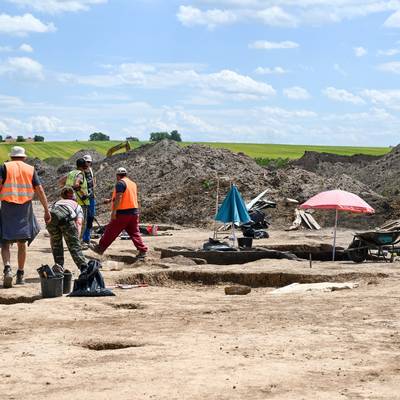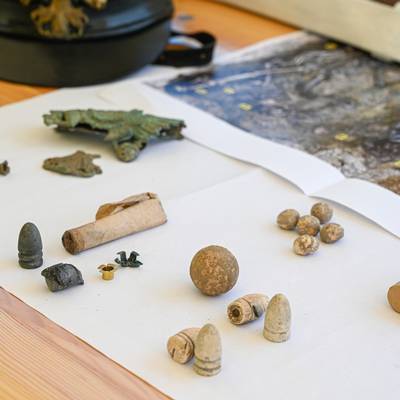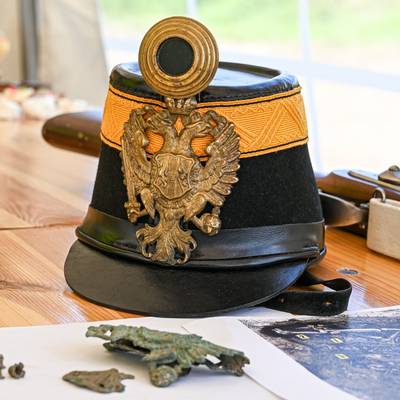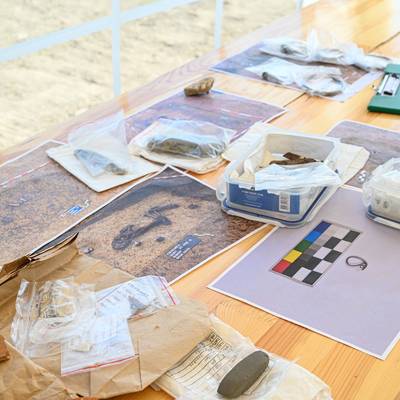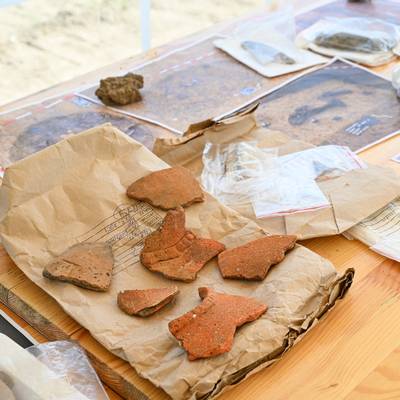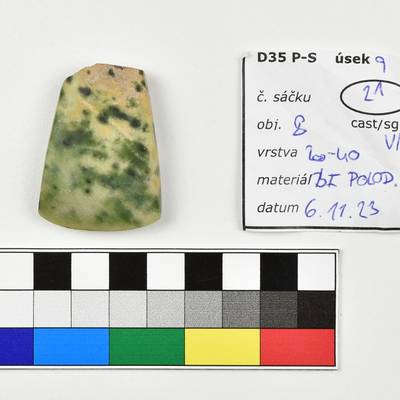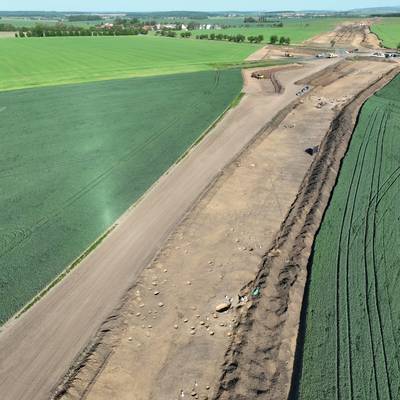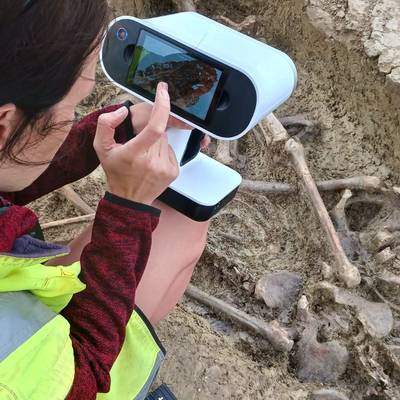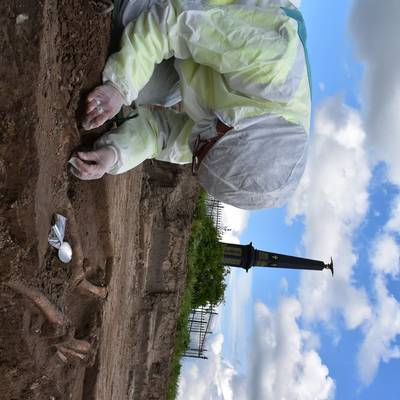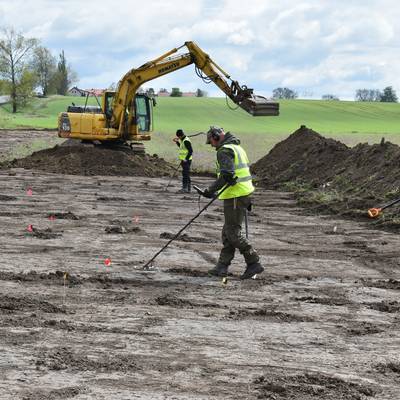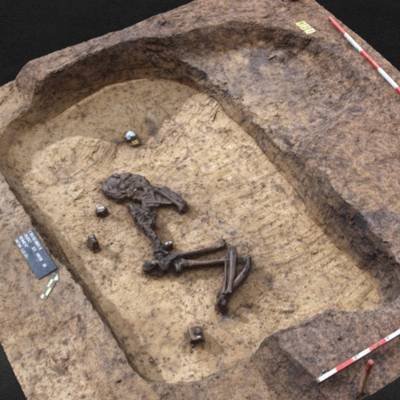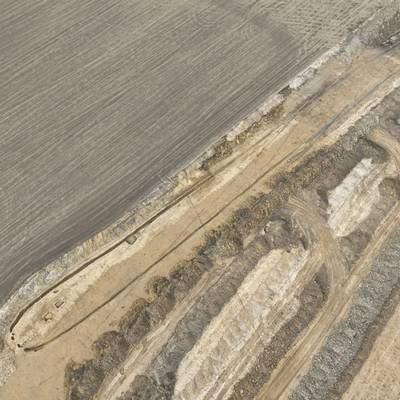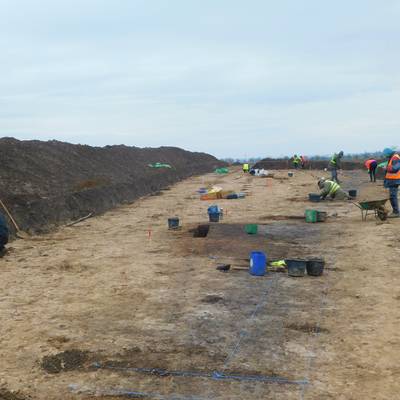Archaeologists from the Philosophical Faculty UHK Discover the Longest Prehistoric Barrow in Europe
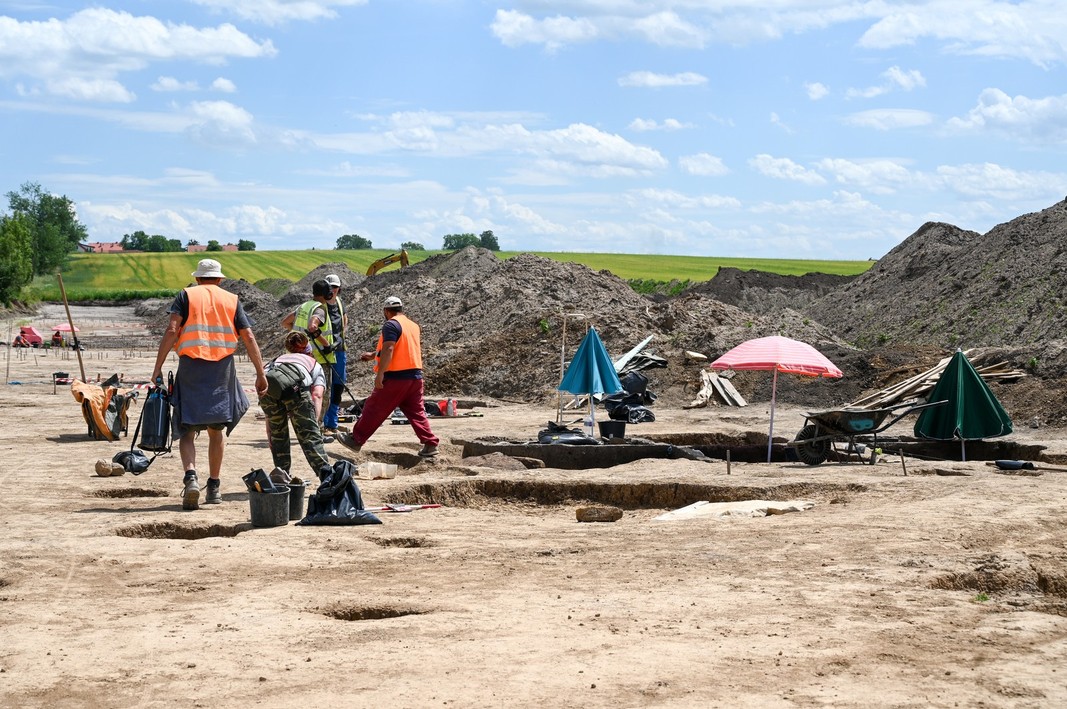
Archaeologists have made significant discoveries of European importance during large-scale rescue excavations conducted before the construction of the D35 highway. Among the remarkable finds, ranging from prehistoric burial monuments to graves from 1866, were found in the currently studied section between Sadová and Plotiště nad Labem. Archaeological research along the D35 highway has been ongoing since 2022.
The work began with non-destructive landscape surveys using geophysical methods, including extensive detector prospecting and pedological sounding, along with the surface uncovering of the landscape strip planned for construction.
Hundreds of Objects from Several Prehistoric Periods
Several dozen prehistoric objects were uncovered in sections adjacent to the intersection with the D11 highway. “The objects can be divided into two categories: funerary and settlement objects. Two objects were interpreted as graves dating to the early Bronze Age, specifically the Únětice culture. Other objects are of a settlement nature, including storage pits,” explains Marek Bartoš from the Archaeological Center Olomouc.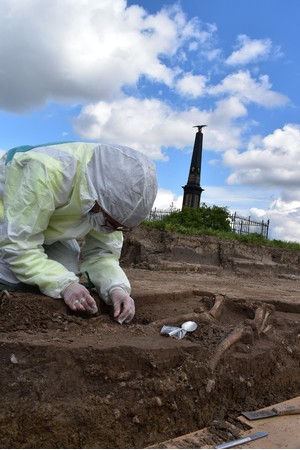
In another section near Všestary, the intensity of finds gradually increased. “In this section, we encountered several hundred archaeological situations dating to the Funnelbeaker and Únětice cultures,” adds Daniel Stozl from the Archaia company.
Archaeologists from Slovenia, specifically from the NGO Skupina STIK, also participated in the research. “Near the Melounka stream, which divides our more than kilometer-long section into two approximately equal parts, we found a soldier’s grave from the 1866 battle. His equipment was very well preserved, allowing us to identify him as an Austrian artilleryman who died from wounds caused by a Prussian bullet – found in the abdominal area. In the western part of the section, we excavated an extensive La Tène settlement. Based on the preserved floor plans of the buildings, especially the storage structures typical of this period, we assume it was the economic base of a much larger settlement extending further west, currently being studied by colleagues from the Hradec Králové Museum. In the eastern part of the section, near Všestary, we are also excavating an early medieval settlement, essentially the predecessor of today’s village,” describes René Masaryk from Skupina STIK.
Archaeologists Discover the Longest Prehistoric Barrow in Europe
An archaeologist team from the Philosophical Faculty UHK (FF UHK) discovered a unique long barrow from the Stone Age at the boundary between Dlouhé Dvory and Lípa. The structure, dating back to the 4th millennium BC, is one of the earliest burial monuments in Europe. Its length of about 190 meters is unparalleled among similar structures.
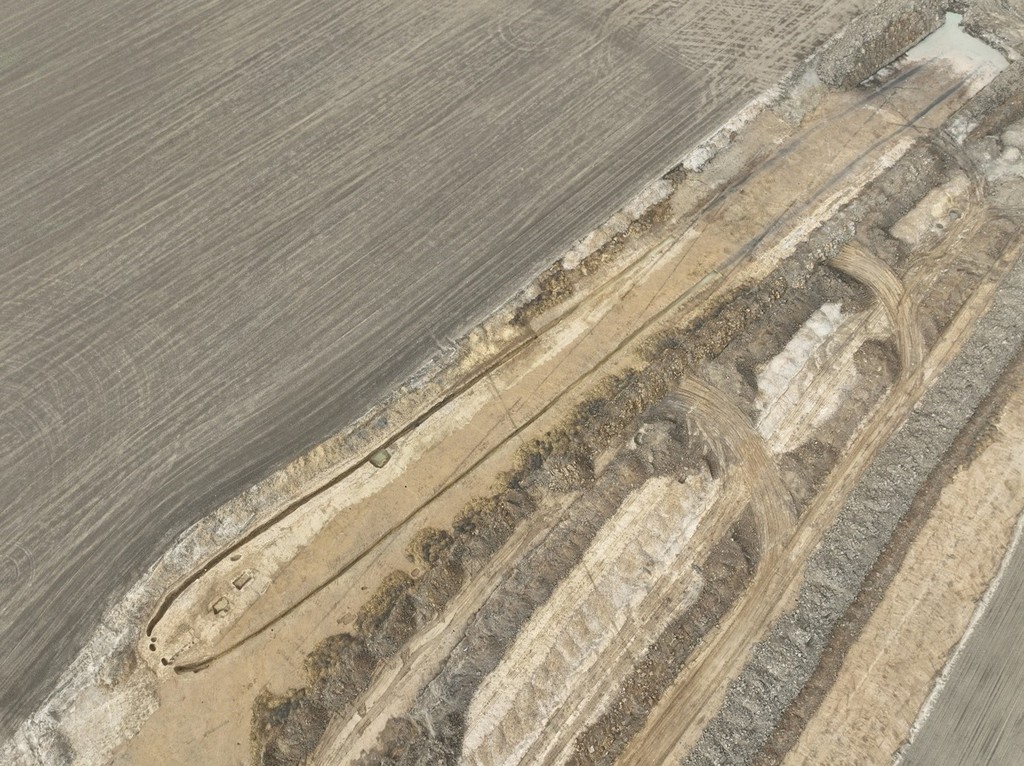
“We typically encounter barrows of this type primarily in northwestern Bohemia. They have not been reliably documented in eastern Bohemia until now. Moreover, the excavated feature represents the longest prehistoric barrow in our region and probably in all of Europe,” explains Petr Krištuf from the Department of Archaeology at the Philosophical Faculty UHK. The barrow is approximately 190 meters long and 15.1 meters wide at its widest point, oriented northeast-southwest.
Similar burial mounds in Central Europe typically contain only one, at most two, burials. From this perspective, it will be interesting to examine how the discovered graves are related and whether they represent burials of related individuals.
“The barrow mound has not been preserved, which is common since most barrows from this period are located in long-term agricultural areas, and their mounds have long since been plowed over. Only the ditch around its perimeter has been preserved. Typically, traces of a palisade, known as postholes, are found in this ditch; however, in the case of this barrow, we have not found such evidence yet,” notes Sylva Tichá Bambasová, head of the field research.
At least four burials were discovered within the barrow. “Similar barrows in Central Europe usually contain only one or two burials. It will be interesting to observe how the discovered graves relate to each other and whether they represent burials of related individuals,” continues Petr Krištuf. In addition to grave goods, which include ceramic vessels and stone objects, scientists took dozens of samples from the graves to learn more about the buried individuals’ kinship, origin, and diet. The barrow research thus uses various scientific methods.
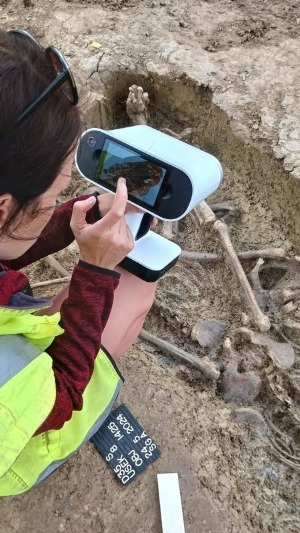 Prehistoric burials were also found around the barrow. Archaeologists discovered about 30 more graves, suggesting the barrow was the foundation for a gradually expanded cemetery. Burial activities here could have continued for several centuries. “Finds from graves around the barrow are currently being processed in the laboratories of the Centre of field Archaeology at the University of Hradec Králové. We are focusing mainly on determining the age of individual burials. DNA analyses will follow, hopefully bringing us closer to understanding the buried population,” adds Sylva Tichá Bambasová. The study of a nearby settlement from the same period as the investigated barrow will reveal much about the lifestyle of the people in the region at that time. Archaeologists are studing the house floor plans and remnants of storage pits containing prehistoric vessels just a few hundred meters from the unique burial structure. This research will continue until mid-September.
Prehistoric burials were also found around the barrow. Archaeologists discovered about 30 more graves, suggesting the barrow was the foundation for a gradually expanded cemetery. Burial activities here could have continued for several centuries. “Finds from graves around the barrow are currently being processed in the laboratories of the Centre of field Archaeology at the University of Hradec Králové. We are focusing mainly on determining the age of individual burials. DNA analyses will follow, hopefully bringing us closer to understanding the buried population,” adds Sylva Tichá Bambasová. The study of a nearby settlement from the same period as the investigated barrow will reveal much about the lifestyle of the people in the region at that time. Archaeologists are studing the house floor plans and remnants of storage pits containing prehistoric vessels just a few hundred meters from the unique burial structure. This research will continue until mid-September.
“The significance of discovering the long barrow at the cadastral boundary of Dlouhé Dvory / Lípa is not only in its size. For the first time, we can essentially study this burial structure in the broader context of the prehistoric landscape. We can study its relationship to the then-settlement and the perception of space in its immediate vicinity. Initial results indicate that the monumental burial barrow stood here for centuries, concentrating local people’s burial and ritual activities around it. It was thus an important ritual site and a landmark in the ancient landscape,” concludes Petr Krištuf.
In addition to finds from the Eneolithic period, an early medieval cemetery with 25 graves was located in section 6 and partly in section 5 in the cadastral area of Dlouhé Dvory. One notable grave contained a silver earring, two amber beads, and a glass bead, a unique find in eastern Bohemia.
Currently, archaeologists from UHK are also conducting research in the eastern part of section 5, in the cadastral area of Rozběřice. Over 700 archaeological objects have been identified here so far. Preliminary results suggest a settlement from the Roman period (1st–4th century AD), including numerous ceramic fragments typical of settlement environments, a decorated bone comb, and an amber bead, both from settlement objects.
Unique La Tène Settlement, Migration Period Graves, and Remnants from the 1866 Battle of Hradec Králové
The Museum of Eastern Bohemia in Hradec Králové (MVČ) provides intensive detector prospecting for the research. “More than 15,000 artifacts have been obtained through detector prospecting. A significant number is related to the Battle of Hradec Králové, but a unique collection of La Tène period finds was also acquired. This was made possible by precise and phased topsoil stripping conducted in 10 cm layers and repeated detector prospecting,” Matouš Holas from MVČ explains.
“Archaeological research also uncovered a warrior’s burials from the Migration Period. Among the significant finds is discovering an exceptionally extensive La Tène settlement with evidence of specialized production activities, unparalleled in eastern Bohemia,” adds Miroslav Novák from MVČ.
These specialized analyses aim to try to identify individual soldiers. And if luck is on our side, perhaps we can find living relatives of the fallen soldiers through these DNA profiles.
From the Prussian-Austrian War of 1866, two individual graves have been examined in the cadastral area of Čistěves. Both were identified as members of the Prussian army. One was shot in the head by an Austrian bullet, and the other sustained shattering fractures to both shin bones and the left arm bone. All found remains of fallen soldiers will undergo DNA analysis and pathological evaluation.
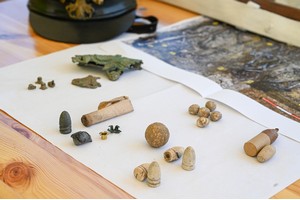 “The remains of the fallen will be respectfully reburied at the battlefield in a newly constructed ossuary, which will be located near the monument of the 49th Infantry Regiment in the cadastral area of Čistěves, which must be moved due to highway construction,” adds Ladislav Rytíř from FF UHK.
“The remains of the fallen will be respectfully reburied at the battlefield in a newly constructed ossuary, which will be located near the monument of the 49th Infantry Regiment in the cadastral area of Čistěves, which must be moved due to highway construction,” adds Ladislav Rytíř from FF UHK.
Lastly, in the cadastral area of Sovětice, a rich multi-cultural settlement with more than a thousand archaeological situations, mostly remains of stakeholes, storage pits, and two kilns or wells were identified. This site features cultures with linear pottery culture from the late Stone Age, Funnelbeaker culture from the late Stone Age, tumulus culture from the Bronze Age, the Roman period, and the Migration Period.
“Among the most interesting finds is a Paleolithic tool, reworked and partially shaped in the younger Neolithic period. A unique polished axe made of serpentinite from the late Stone Age is also noteworthy,” explains Veronika Rohanová from MVČ.
The archaeological research involves the Department of Archaeology at the Philosophical Faculty of the University of Hradec Králové, the Museum of Eastern Bohemia in Hradec Králové, the Slovenian group Skupina STIK, Archaia, and the Archaeological Center Olomouc.
The discoveries in global media
Newsweek National Geographic PL Archaeology News Online Magazine ArkeonewsMiami HeraldHeritage DailyAncient OriginsGround NewsThe Science Times Morgen PostPrague MorningLa Brujula Verde


